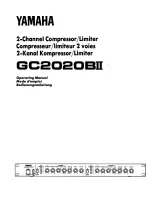
10
the compressor must be replaced. If large amounts of
carbon build-up are present on the two main surfaces, in
the two discharge valve holes or between the discharge
valve and the discharge seat, the compressor should
be replaced.
REAR END COVER
Visually inspect for cracks and external damage. Check
the crankshaft rear bearing diameter in the rear end cover
(8) for excessive wear, fl at spots or galling. Check the
hydraulic pump attachment pilot and threaded holes for
damage. Minor thread chasing is permitted, but do not
re-cut the threads. If any of these conditions are found,
replace the compressor.
CRANKCASE
Check the cylinder head gasket surface on the deck (top) of
the crankcase (11) for nicks, gouges, and marring. A metal
gasket is used to seal the cylinder head to the crankcase.
This surface must be smooth and free of all but the most
minor scratching. If excessive marring or gouging is
detected, the compressor must be replaced.
Check the condition of the countersunk hole on the deck
of the crankcase (11) that retains the o-ring and prevents
coolant leakage between the valve plate assembly and the
crankcase. The surface in contact with the o-ring should
be smooth and free of any scratches and gouges that could
causes leakage around the o-ring.
ASSEMBLY
General Note: All torques specifi ed in this manual are
assembly torques and typically can be expected to fall off
after assembly is accomplished. Do not re-torque after
initial assembly torques fall unless instructed otherwise.
A compiled listing of torque specifi cations is presented on
page 11.
INCH POUNDS TO FOOT POUNDS
To convert inch pounds to foot pounds of torque, divide
inch pounds by 12.
Example: 12 Inch Pounds = 1 Foot Pound
12
FOOT POUNDS TO INCH POUNDS
To convert foot pounds to inch pounds of torque, multiply
foot pounds by 12.
Example: 1 Foot Pound x 12 = 12 Inch Pounds
CRANKCASE FRONT COVER
1. Position the new cover (10) over the hole in the front of
the crankcase. Using a rubber mallet, drive the cover
into the hole in the front of the crankcase (11), until the
outside diameter of the cover is fl ush with cast surface.
REAR END COVER
1. Install the o-ring (9) on the rear end cover.
2. Orient the rear end cover (8) to the crankcase (11)
using the reference marks made during disassembly.
Carefully install the rear end cover in the crankcase (11)
making certain not to damage the crankshaft bearing
surface.
3. Install the two end cover cap screws (7). Refer to Figure
9 to ensure that the two cap screws (7) are installed
in the proper crankcase (11) bolt holes. “Snug” the
screws, then tighten to between 195 to 212 inch pounds
(22-24 Nm).
CYLINDER HEAD, COOLING PLATE & VALVE PLATE
ASSEMBLY
1. Install the crankcase o-ring (12) into the slightly
countersunk hole on the deck of the crankcase.
2. Note the position of the protruding crankcase (11)
alignment pins on the deck (top) of the crankcase.
Install the metal inlet reed valve/gasket (5) over the
alignment pins on the crankcase; being careful not to
disturb the crankcase o-ring (12).
3. Position the valve plate assembly (13) on the crankcase
(11) so that the alignment pins in the crankcase fi t into
the corresponding holes in the valve plate assembly
(13).
4. Position one of the embossed metal head gaskets
(4) over the alignment bushings protruding from the
cooling plate (14). Position the second embossed
metal head gasket over the alignment bushings on the
opposite side of the cooling plate (14). When properly
positioned, the outline of the two embossed gaskets
match the outline of the cooling plate.
5. Install the cooling plate with the head gaskets onto the
valve plate assembly. Align the alignment bushings on
the cooling plate over the oversized countersunk holes
of the valve plate assembly. Again, when properly
installed, the outline of the cooling plate matches the
outline of the valve plate assembly.
6. Position and install the cylinder head (15) over the
alignment bushings protruding from the cooling plate.
When properly installed, the outline of the cylinder head
assembly will match the outline of the cooling plate and
valve plate assembly.
Note:
To assist with correct installation, the alignment
bushings only fi t into two, of the four, cylinder head cap
screws.
7. "Snug" the four hex head cylinder head cap screws
(1) and snug them, then tighten evenly to a torque of
265 to 292 inch pounds (30-33 Nm) using a crossing
pattern.
Note: A light fi lm of oil should be applied
to the thread of these bolts prior to installation. Oil
should not be applied to any other bolts.
Содержание 360CC
Страница 12: ...12 Notes...











































